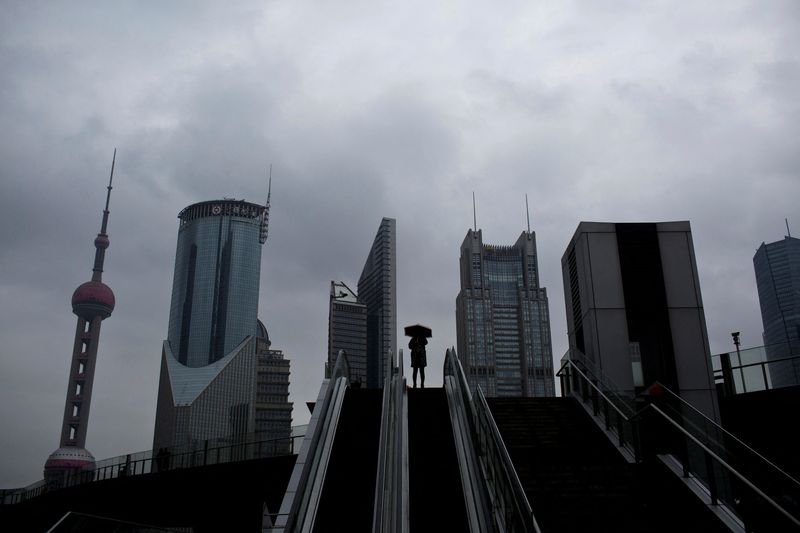China’s reopening brightens developing Asia’s 2023 growth outlook – ADB
2023.04.03 20:16

© Reuters. FILE PHOTO: A woman holds an umbrella on an escalator in the financial district of Pudong, Shanghai, November 25, 2014. REUTERS/Aly Song
By Karen Lema
MANILA (Reuters) – Developing Asia will grow faster than previously thought this year, underpinned by a stronger-than-projected rebound in China, but risks from global banking turmoil could weigh on the outlook, the Asian Development Bank (ADB) said on Tuesday.
Developing Asia, which groups together 46 economies in the Asia-Pacific, is forecast to grow 4.8% in 2023, the ADB said in its Asian Development Outlook report, more than its previous estimate of 4.6% in December, and following 4.2% growth in 2022.
Driving the region’s growth this year is China’s recovery after it ended its zero-COVID policy in December, with the world’s second-biggest economy seen expanding 5.0% this year, the ADB said, above its earlier estimate of 4.3%.
China’s reopening “is really going to create the strongest kind of support for growth in the region this year,” ADB Chief Economist Albert Park told Reuters.
And while China’s embattled property sector “remains a point of concern”, Park said the upside risks to China’s growth outlook outweigh downside risks.
“If life really returns to normal quickly and confidence comes back, growth could even be higher than 5% which would be obviously even better for the region,” Park said.
Excluding China, the region is expected to grow 4.6% this year, slower than the previous year’s 5.4% pace.
By subregion, South Asia is expected to record the fastest expansion of 5.5% this year, buoyed by India’s projected growth of 6.4% this year, followed by Southeast Asia, which is forecast to grow 4.7% this year.
Even as growth in developing Asia gathers pace, the ADB warned challenges remain, including turbulence in the global banking sector and an escalation in the Ukraine war, which could cause a surge in commodity prices.
But for now, turmoil in the global banking sector, triggered by the collapse of two mid-sized U.S. lenders, will not turn into “a bigger crisis of the financial system in the U.S.”, Park said even as he urged policymakers to stay vigilant.
Working in the region’s favour is the expected easing in inflation, which would reduce the need for frequent and sizeable interest rate hikes that could dampen consumption.
From 4.4% in 2022, inflation is forecast to decelerate to 4.2% this year and 3.3% next year, the ADB said, but it warned that core inflation remained high in some economies and required close monitoring.
In a separate media briefing, Park said a surprise announcement by OPEC+ to cut production introduces another challenge for the region as this could drive oil prices higher. Currently, the ADB forecasts oil prices to average $88 a barrel this year and $90 next year.
GDP GROWTH 2021 2022 2023 2023 2024
DEC APR APR
Caucasus and 5.8 5.1 4.2 4.4 4.6
Central Asia
East Asia 7.9 2.8 4.0 4.6 4.2
China 8.4 3.0 4.3 5.0 4.5
South Asia 8.4 6.4 6.3 5.5 6.1
India 9.1 6.8 7.2 6.4 6.7
Southeast Asia 3.5 5.6 4.7 4.7 5.0
Indonesia 3.7 5.3 4.8 4.8 5.0
Malaysia 3.1 8.7 4.3 4.7 4.9
Myanmar -5.9 2.0 n/a 2.8 3.2
Philippines 5.7 7.6 6.0 6.0 6.2
Singapore 8.9 3.6 2.3 2.0 3.0
Thailand 1.5 2.6 4.0 3.3 3.7
Vietnam 2.6 8.0 6.3 6.5 6.8
The Pacific -1.4 5.2 4.8 3.3 2.8
Developing Asia 7.2 4.2 4.6 4.8 4.8
INFLATION
DEC APR APR
Central Asia 9.0 12.9 8.5 10.3 7.5
East Asia 1.1 2.3 2.4 2.3 2.0
China 0.9 2.0 2.3 2.2 2.0
South Asia 5.8 8.2 7.9 8.1 5.8
India 5.5 6.7 5.8 5.0 4.5
Southeast Asia 2.0 5.0 4.5 4.4 3.3
Indonesia 1.6 4.2 5.0 4.2 3.0
Malaysia 2.5 3.4 3.0 3.1 2.8
Myanmar 3.6 16.0 n/a 10.5 8.2
Philippines 3.9 5.8 4.3 6.2 4.0
Singapore 2.3 6.1 5.5 5.0 2.0
Thailand 1.2 6.1 2.7 2.9 2.3
Vietnam 1.8 3.2 4.5 4.5 4.2
The Pacific 3.1 5.7 5.0 5.0 4.4
Developing Asia 2.6 4.4 4.2 4.2 3.3








